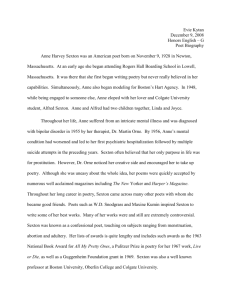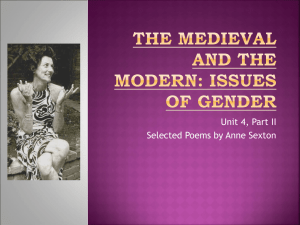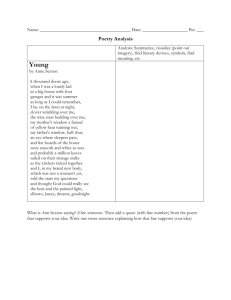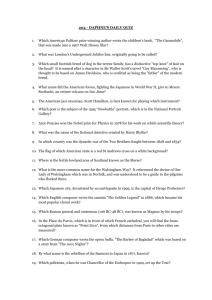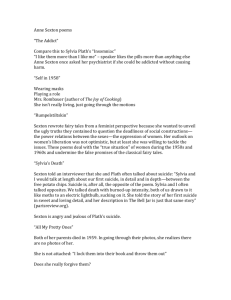Madness and Creativity: Dr. Norah Hadi Alsaeed Mediterranean Journal of Social Sciences
advertisement
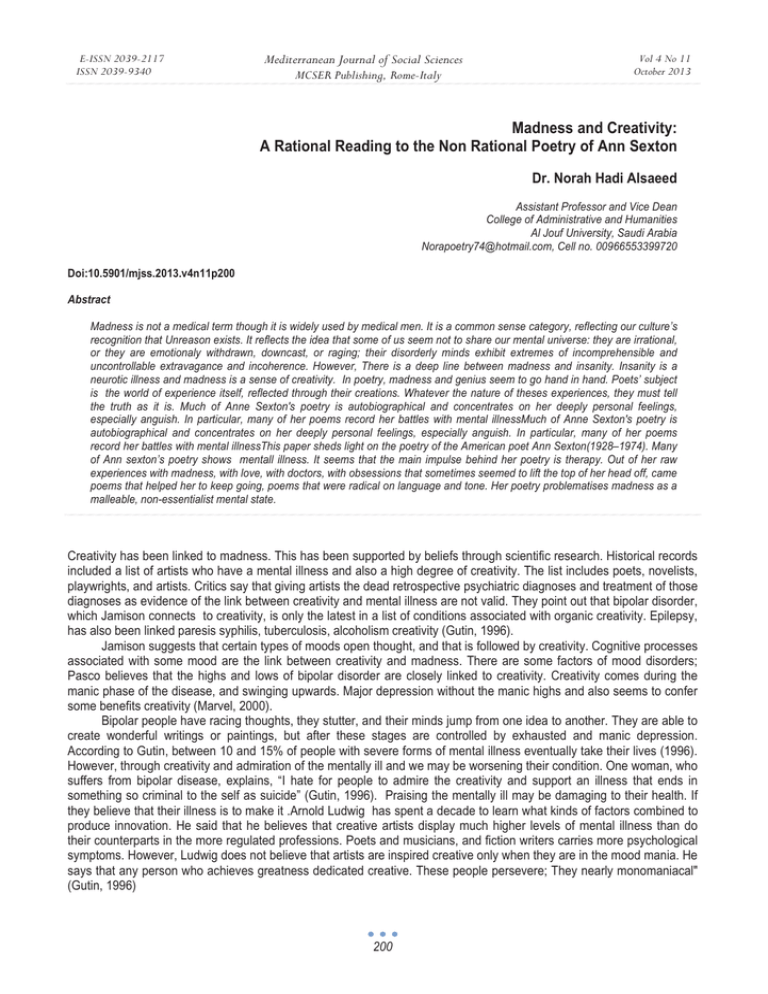
E-ISSN 2039-2117 ISSN 2039-9340 Mediterranean Journal of Social Sciences MCSER Publishing, Rome-Italy Vol 4 No 11 October 2013 Madness and Creativity: A Rational Reading to the Non Rational Poetry of Ann Sexton Dr. Norah Hadi Alsaeed Assistant Professor and Vice Dean College of Administrative and Humanities Al Jouf University, Saudi Arabia Norapoetry74@hotmail.com, Cell no. 00966553399720 Doi:10.5901/mjss.2013.v4n11p200 Abstract Madness is not a medical term though it is widely used by medical men. It is a common sense category, reflecting our culture’s recognition that Unreason exists. It reflects the idea that some of us seem not to share our mental universe: they are irrational, or they are emotionaly withdrawn, downcast, or raging; their disorderly minds exhibit extremes of incomprehensible and uncontrollable extravagance and incoherence. However, There is a deep line between madness and insanity. Insanity is a neurotic illness and madness is a sense of creativity. In poetry, madness and genius seem to go hand in hand. Poets’ subject is the world of experience itself, reflected through their creations. Whatever the nature of theses experiences, they must tell the truth as it is. Much of Anne Sexton's poetry is autobiographical and concentrates on her deeply personal feelings, especially anguish. In particular, many of her poems record her battles with mental illnessMuch of Anne Sexton's poetry is autobiographical and concentrates on her deeply personal feelings, especially anguish. In particular, many of her poems record her battles with mental illnessThis paper sheds light on the poetry of the American poet Ann Sexton(1928–1974). Many of Ann sexton’s poetry shows mentall illness. It seems that the main impulse behind her poetry is therapy. Out of her raw experiences with madness, with love, with doctors, with obsessions that sometimes seemed to lift the top of her head off, came poems that helped her to keep going, poems that were radical on language and tone. Her poetry problematises madness as a malleable, non-essentialist mental state. Creativity has been linked to madness. This has been supported by beliefs through scientific research. Historical records included a list of artists who have a mental illness and also a high degree of creativity. The list includes poets, novelists, playwrights, and artists. Critics say that giving artists the dead retrospective psychiatric diagnoses and treatment of those diagnoses as evidence of the link between creativity and mental illness are not valid. They point out that bipolar disorder, which Jamison connects to creativity, is only the latest in a list of conditions associated with organic creativity. Epilepsy, has also been linked paresis syphilis, tuberculosis, alcoholism creativity (Gutin, 1996). Jamison suggests that certain types of moods open thought, and that is followed by creativity. Cognitive processes associated with some mood are the link between creativity and madness. There are some factors of mood disorders; Pasco believes that the highs and lows of bipolar disorder are closely linked to creativity. Creativity comes during the manic phase of the disease, and swinging upwards. Major depression without the manic highs and also seems to confer some benefits creativity (Marvel, 2000). Bipolar people have racing thoughts, they stutter, and their minds jump from one idea to another. They are able to create wonderful writings or paintings, but after these stages are controlled by exhausted and manic depression. According to Gutin, between 10 and 15% of people with severe forms of mental illness eventually take their lives (1996). However, through creativity and admiration of the mentally ill and we may be worsening their condition. One woman, who suffers from bipolar disease, explains, “I hate for people to admire the creativity and support an illness that ends in something so criminal to the self as suicide” (Gutin, 1996). Praising the mentally ill may be damaging to their health. If they believe that their illness is to make it .Arnold Ludwig has spent a decade to learn what kinds of factors combined to produce innovation. He said that he believes that creative artists display much higher levels of mental illness than do their counterparts in the more regulated professions. Poets and musicians, and fiction writers carries more psychological symptoms. However, Ludwig does not believe that artists are inspired creative only when they are in the mood mania. He says that any person who achieves greatness dedicated creative. These people persevere; They nearly monomaniacal" (Gutin, 1996) 200 E-ISSN 2039-2117 ISSN 2039-9340 Mediterranean Journal of Social Sciences MCSER Publishing, Rome-Italy Vol 4 No 11 October 2013 Dedication instead of madness may be the real factor that generates creative greatness. Albert Rothenberg is a clinical professor of psychiatry at Harvard University, and spent twenty-five Years in the study of the creative process. He said he believes that there are special and specific thought processes used by the creators during the creation process: Translogical types of thinking characterize both psychosis and people a high degree of creativity. Translogical Thinking is the kind of imagine the thought processes beyond the common methods in normal logical thinking. This kind of thinking involves processes. The Janusian and Homospatial thinking is the process to combine objects conscience contradictory or hostile in one Entity. Homospatial Process is the essence of a good metaphor. Jansuian Thinking tends to occur in the early stages of the creative work when ideas are generated, and Homospatial thinking characterizes the development of creative ideas. There are similarities between the initial thought process of psychosis Translogical thinking with some subtle differences. (Neihart, 1998) Thus, metaphors and ironies are essential elements in the creative poetry. Poets make intelligently utilize them to promote their business. There are a set of lists famous American poets, many of whom have won a Pulitzer Prize. Among them are Anne Sexton and Sylvia Plath, along with Robert Lowell, John Barryman, Hart Crane, and others. Most of these poets are mentally ill, many of whom had committed suicide. Many writers and artists talking about periods of inspiration when I think processes are created to accelerate and moods and new associations. It is possible that genetic vulnerability to mood disorders and independently accompanied by a tendency to creativity. Genetic patterns associated with bipolar disorder may carry a spark of creativity (Barlow and Durand,1999). Anne Sexton is dedicated her character and continue to produce long after the point of physical exhaustion, but still met , sometimes, with criticism and rejection, which can accelerate the vicious circle of self-abasement. This paper will highlight the creativity of Anne Sexton regarding madness. The paper will highlight also Sexton’s representation of herself in sense of madness by using metaphors in different persona. The paper also questions gender construction of madness in many of her confessional poems. Anne Sexton (1928-1974) is an American confessional poet suffered from mental illness. This has been caused from severe mental illness and many circumstances in her personal life affected her: her father is an alcoholic, and she feels that her parents are hostile towards her. And her relationship with her beloved great aunt, Nana affected her psychology, When the latter has a mental breakdown and hospitalization. Sexton was sent to Rogers Hall, a boarding school. Then when she is nineteen years old and she escapes with Alfred "Kayo" Sexton II. Her husband was a salesman and was often away from home. Nana dies, she is alone with two children, and during this time she sometimes abuses them. She unexpectedly lost both of her parents, which leads to more mental breakdowns. After several suicide attempts are institutionalized. All these circumstances encourage her to writing, and her poetry becomes essential to life. Through her poetry and she strives to find stability (Wagner, Martin,2000.). She possesses the ability to attract us to the fantasy worlds of her with her stunning, rhythmic words. She opens our minds and feed our imagination. Her poetry reflects her personal life, intimate details of her private life, including relations with her husband and children, depression, isolation and despair, alcohol, and death. The work also includes specific issues of women as adultery and abortion. Her poetry indicates a mentally ill persona. As events throughout her lives Sexton will worsen psychological stability to her, she finds solace in her poetry. Anne Sexton says, “Poetry led me by the hand out of madness” (Neihart, 1996). Yet, the creative madness is devastating irony. It inspires Sexton to create a haunting poetry, but it also entices her self-destructive urges. Through poetry she reveals her deep, personal emotions, the emotions threatening her sanity. Anne Sexton’s poem “Her Kind” depicts psychological and feminine angst: I have gone out, a possessed witch, Haunting the black air, braver at night; Dreaming evil, I have done my hitch Over the plain houses, light by light: Lonely thing, twelve-fingered, out of mind. A woman like that is not a woman, quite. I have been her kind. (Her Kind)1-21Kennedy and Gioia, 1996) In the above lines she characterizes herself. They indicate that this kind of woman is a different kind whom not easy to be understood. Sexton’s life was not easy, and she made life hell for her husband, her kids, and anyone who really loved her. She said: “All I wanted was a little piece of life, to be married, to have children…. I was trying my damnedest to lead a conventional life, for that was how I was brought up, and it was what my husband wanted of me. But one can’t build 201 E-ISSN 2039-2117 ISSN 2039-9340 Mediterranean Journal of Social Sciences MCSER Publishing, Rome-Italy Vol 4 No 11 October 2013 little white picket fences to keep the nightmares out.” The condition in the above lines indicates that her poem has a directness of expression that puts a chill on one’s spine: I have found the warm caves in the woods, filled them with skillets, carvings, shelves, closets, silks, innumerable goods; fixed the suppers for the worms and the elves: whining, rearranging the disaligned. A woman like that is misunderstood. I have been her kind. I have ridden in your cart, driver, waved my nude arms at villages going by, learning the last bright routes, survivor where your flames still bite my thigh and my ribs crack where your wheels wind. A woman like that is not ashamed to die. I have been her kind. (Her Kind, 1-21) The poem is a serious attempt to understand such a woman, her sense of alienation, motivated her to death by the evil absorb and give voice: a chortling, complacent, perfectly amiable sound suggesting that "evil" is probably the wrong word after all. Witch sexton, waving her 'bare arms in the villages going by,' becomes something of value to the community, woman in the service of the private sector, which is inexhaustible and anger, and a demon with red hair that revenge is "eat men like witch air'-Sexton is essentially harmless. Although they are still vulnerable - 'A woman like that is not afraid because it refuses die'-rage in favor of humor, flamboyance, - a mockery of self. are the kind of leisure and entertainment harmful, and if it seems they are cast in the role of a martyr, and embrace the madness in order to domesticate it for the rest of making a society that seems less of a threat, and perhaps even enjoyable, but that martyrdom is that this aspect of Sexton accepted with a strange zest. Love is mentioned repeatedly in her poems. She is involved in many Love affairs, including the involvement of long-sexual with her psychiatrist. Her writing career peaks as they receive rewards and honors for her poetry, but strains her fame of marriage. Intimate relations is also part of her creation, love for her: “Love? Be it man. Be it woman. It must be a wave you want to glide in on, give your body to it, give your laugh to it, give, when the gravelly sand takes you, your tears to the land. To love another is something like prayer and can't be planned, you just fall into its arms because your belief undoes your disbelief.” (the complete poems) “I am alone here in my own mind. There is no map and there is no road. It is one of a kind just as yours is.” “Yet love enters my blood like an I.V., dripping in its little white moments.” "Waking Alone." The following sweet lines indicate the love receipt A mixture of drink, drugs, and a lifetime battle with mental illness took its toll on her relationships, certainly, but it also took its toll on her writing gift, which you can see in those later lines. They don’t just read as hallucinatory or unclear. They come off as amateur: “You, Doctor Martin, walk from breakfast to madness. Late August, I speed through the antiseptic tunnel where the moving dead still talk of pushing their bones against the thrust of cure. And I am queen of this summer hotel or the laughing bee on a stalk 202 E-ISSN 2039-2117 ISSN 2039-9340 Mediterranean Journal of Social Sciences MCSER Publishing, Rome-Italy Vol 4 No 11 October 2013 of death. We stand in broken lines and wait while they unlock the doors and count us at the frozen gates of dinner. The shibboleth is spoken and we move to gravy in our smock of smiles. We chew in rows, our plates scratch and whine like chalk in school. (You, Doctor Martin) If theses mature feelings could not be understood, depression also seems to be a reaction to the failure of sympathy on the part of others. When people fail that it is important to understand, recognize and acknowledge and appreciate, or respond in a way that we hoped to do, which could be sufficient to produce injury depression. It is as if their failure to deliver the message that we are not good enough, worthwhile or important. It slight to respect ourselves and it does not even have to be of great proportions. Some people are more sensitive to this type of injury because of their personal history, so a slight small it may well be as important as a result of the rejection of psychological Home. After being divorced, loneliness, depression, and addiction to alcohol consumed her. The persona in Sexton’s poems is in many places depressed and once she finds herself bored, suicide is the exercise of free will: “Depression is boring, I think and I would do better to make some soup and light up the cave.” (depression is boring) Psychological theories and depression traditionally explained as "anger turned inward against the self." If you do not live up to some of the internal standards of the World Health Organization or what you're supposed to be, and notes some of the International Atomic Energy Agency internal failure and starts to let you know that you were not all that you can have - depression. People often talk about being angry with them selves because they did not materialize, or check or do what they think they should be. This is interpreted to diminished self-esteem depressed people often offers. In a letter to Ann Clark, sexton States that "When (for me) Death takes you and puts you through the wringer, it's a man., But when you kill yourself she was a woman." She writes: “Anne, I don't want to live. . . . Now listen, life is lovely, but I Can't Live It. I can't even explain. I know how silly it sounds . . . but if you knew how it Felt. To be alive, yes, alive, but not be able to live it. Ay that's the rub. I am like a stone that lives . . . locked outside of all that's real. . . . Anne, do you know of such things, can you hear???? I wish, or think I wish, that I were dying of something for then I could be brave, but to be not dying, and yet . . . and yet to [be] behind a wall, watching everyone fit in where I can't, to talk behind a gray foggy wall, to live but to not reach or to reach wrong . . . to do it all wrong . . . believe me, (can you?) . . . what's wrong. I want to belong. I'm like a jew who ends up in the wrong country. I'm not a part. I'm not a member. I'm frozen.” (Sexton and Gray, 1977) They are looking for sympathy through love relationships, but needs to provide comfort and security have not been met. According to one source, she attempts to anesthetize her emotions with alcohol. She said she checks in and out of clinics where doctors tried to minister Hysteria, depression, anorexia, insomnia, violently rotating mood Some critics regard her dependence on alcohol as compromising her last work. In October 1974, she herself pours a glass of vodka, and go to her garage, Close the door, and starts in her car, listening to the radio as exhaust fumes kill (Morrow, 1991). It is difficult to conclude that all the writers and creative artists are mentally ill. a study Conducted by Bob Boyce, a professor of psychology, suggests that "creativity productivity seems to occur more reliably with the moderation of the duration of action and emotions, not with fatigue and depression that followed binge of writing" (Boice, 1997 435). Boyce knows the book binge because the people who write interspersed with a few breaks, in a hurried pace, and are exhausted after their writings sessions. In contrast, regular book writing in short sessions, but regularly and without heated emotions. The study concludes that, in comparison to the regular book, are less likely to achieve acceptance editorial, has a smaller number of creative ideas, and generally achieve much less the book binge. He said he believed that the effectiveness is working better than madness (Boice, 1997, 450-460) 203 E-ISSN 2039-2117 ISSN 2039-9340 Mediterranean Journal of Social Sciences MCSER Publishing, Rome-Italy Vol 4 No 11 October 2013 References Barlow, David H., and Mark. (1999). Durand Abnormal Psychology: An Integrative Approach. Ed. Marianne Taflinger. Pacific Grove: Brooks/Cole Publishing Company.6-7. Boice, Bob. “Which is More Productive, Writing in Binge Patterns of Creative Illness orin Moderation?” Creative Communication 14 (1997): 435-460. Boyers, Robert. (1978). “Live or Die: The Achievement of Anne Sexton.”Anne Sexton: The Artist and Her Critics. Ed. J. D. McClatchy. Bloomington: Indiana UP, 204 -15. Capo, Kay Ellen Merriman.( 1988 ). “‘I Have Been Her Kind’: Anne Sexton’s Communal Voice”. Original Essays on the Poetry of Anne Sexton. Ed. Francis Bixler. Arkansas: U of Central Arkansas P, 22- 45. Goodman, Jenny. “Anne Sexton’s Live or Die.” Original Essays on the Poetry of Anne Sexton. Ed. Francis Bixler. Arkansas: U of Central Arkansas P, 1988. 71- 80. Middlebrook, Diane Wood. (1991). Anne Sexton: A Biography. Boston: Hough Mifflin. .Gutin, Jo Anne. “That Fine Madness.” Discover Oct. 1996: 74-82. Kennedy, X. J., and Dana Gioia. ( 2001). Literature: An Introduction to Fiction, Poetry, and Drama. Ed. Marvel, Bill. “Creative Highs and Lows.” Dallas Morning News 20 Sept. 2000: 1C-2C. SIRS Knowledge Source. Morrow, Lance. .( 1991): “Pains of the Poet and Miracles.” Time: Sept: 76.79. Neihart, Maureen. (1998): “Creativity, the Arts, and Madness.” Roeper Review 21. 47-51. Sexton, Anne. (1966). “Self in 1958.” Live or Die. Boston: Houghton Mifflin, 73. Sexton, Linda Gray, and Lois Ames, eds. (1977). Anne Sexton: A Self-Portrait in Letters. Boston: Houghton Mifflin Wagner-Martin, Linda . (2000) “Anne Sexton’s Life.” Modern American Poetry Feb.1-2 22 Mar. 2001 <http:///www.english.uius.edu/maps/poets/s_z/sexton/sexton_life.htm>. 204

